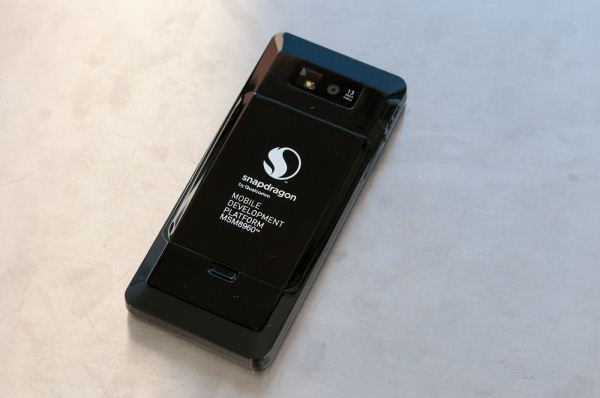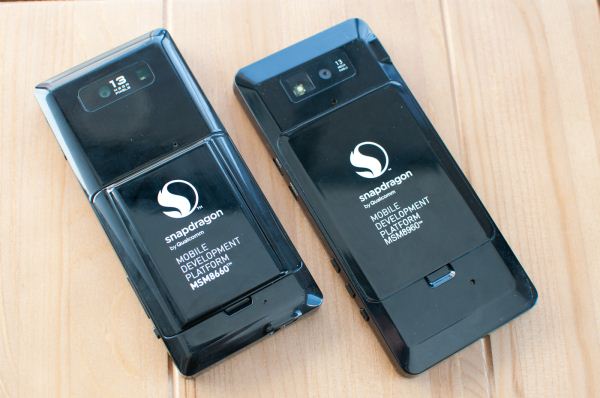Qualcomm Snapdragon S4 (Krait) Performance Preview - 1.5 GHz MSM8960 MDP and Adreno 225 Benchmarks
by Brian Klug & Anand Lal Shimpi on February 21, 2012 3:01 AM EST- Posted in
- Smartphones
- Snapdragon
- Qualcomm
- Adreno
- Krait
- Mobile
If you've been following our SoC and smartphone related coverage over the past couple of years, you'll probably remember how Qualcomm let us take home an MDP8660 from MWC 2011 and thoroughly benchmark it. Qualcomm has done essentially the same thing this year, this time sending their latest and greatest MSM8960 SoC inside the aptly named MSM8960 Mobile Development Platform (MDP) just before MWC 2012. The timing is impeccable as we're fully expecting to start seeing MSM8960 based phones next week at MWC, and we've been telling you to hold off on any smartphone purchases until the 8960's arrival. Today we're finally able to give you an indication of just how fast Qualcomm's next-generation Snapdragon S4 will be.
We've already been teased MSM8960 and Krait a few times, and have talked about the architecture and what to expect from the SoC itself. The super short recap is this: Krait is the name of Qualcomm's new out of order ARMv7-A compatible CPU architecture (previous generations of Snapdragon used Scorpion) which is designed for TSMC's 28nm process. Inside MSM8960 are two Krait cores running at up to 1.5 GHz, Adreno 225 graphics, improved ISP and Qualcomm's new baseband with support for nearly every air interface out there.
The MDP we were sampled is clearly a descendant of the MDP MSM8660 we were given last year, sharing the same black utilitarian look and purpose-built design, though it's notable that the new device is markedly thinner. MDP MSM8960 is running Android 4.0.3 at 1.5 GHz, and includes 1 GB of LPDDR2, and a 4" 1024x600 display. It's an interesting note to make that both Intel and Qualcomm have somehow settled on 1024x600 for their reference designs.
We also asked Qualcomm for a copy of the old MDP8660 for comparison purposes, just to see how far we've come since the first dual core Snapdragon SoC.
| Qualcomm Mobile Development Platform (MDPs) | ||
| MDP MSM8660 | MDP MSM8960 | |
| SoC | 1.5 GHz 45nm MSM8660 | 1.5 GHz 28nm MSM8960 |
| CPU | Dual Core Scorpion | Dual Core Krait |
| GPU | Adreno 220 | Adreno 225 |
| RAM | 1 GB LPDDR2 | 1 GB LPDDR2 |
| NAND | 8 GB integrated, microSD slot | 16 GB integrated, microSD slot |
| Cameras | 13 MP Rear Facing with Autofocus and LED Flash, Front Facing (? MP) | 13 MP Rear Facing with Autofocus and LED Flash, Front Facing (? MP) |
| Display | 3.8" WVGA LCD-TFT | 4.03" SWVGA (1024x600) LCD-TFT |
| Battery | 3.3 Whr removable | 5.6 Whr removable |
| OS | Android 2.3.2 (Gingerbread) | Android 4.0.3 (ICS) |
We're taking a look at just CPU, GPU, and power performance today on MSM8960, as cellular baseband is disabled on the MDP just like it was when we looked at the previous MSM8660 MDP. We'll get a chance to investigate that further in the future, again right now the key areas are CPU, GPU, and power.
As we talked about in the previous MDP piece, the purpose of the MDP is just to serve as a reference design for both Qualcomm to get its Android port running on, and also for individual developers to profile and test their applications against. It's analogous to TI's OMAP Blaze platforms - you won't ever likely see one out in the wild, but it's a reference target that the silicon vendor leverages to port Android, and a piece of hardware that OEMs can use as a reference when they start customizing and building handsets.
Just like last time the MDP also comes with a software build that lets us easily enable or disable vsync on the device, restart surfaceflinger, and then run benchmark tests. There's no such analog for shipping retail devices, only development builds contain this functionality. As there are parts of each benchmark that could instantaneously peak over vsync's 60 FPS on some of the shipping platforms we're comparing to, we're providing results with vsync on and off.
In addition, last time when we ran tests on the MDP MSM8660 I noted that the governor was set to "performance" mode, which means it doesn't adaptively change CPU frequency as a function of load - it was 1.5 GHz all the time. This time the MDP MSM8960 came running with the much more typical "ondemand" governor selected, which does scale CPU frequency as a function of load, so there's less of a concern about the lack of pauses while the CPU changes performance states making results non comparable.


















86 Comments
View All Comments
bhspencer - Tuesday, February 21, 2012 - link
Does anyone know if Linpak is using the hardware or software floating point calculations for the MFLOPS number.metafor - Wednesday, February 22, 2012 - link
Hardware. But it's run on the JIT instead of native code. According to CF-Bench, Java FP performance is around 1/3 of native. Neither actually use NEON but instead uses the older VFP instructions.vision33r - Tuesday, February 21, 2012 - link
The Tegra 3 is actually a big disappointment from a performance standpoint. It actually has 5 CPU cores and the GPU performance isn't much better than the Tegra 2. The Adreno 225 is a much bigger upgrade but I'm afraid that it's another marginal upgrade.The A5 in the iPad2/iPhone 4S are over 1 year old by March. In that time, Nvidia's Tegra 2/3 has not dominated and the MSM8960 is finally a true contender for the fastest SOC on the market. By the time this thing is out in volume, Apple has the A6 ready and most likely another 4-8x performance increase over the A5.
This SOC will probably be forgotten when the A6 is out.
LetsGo - Wednesday, February 22, 2012 - link
Yeah your right looking at my Asus Transformer Prime running GTA 3. /SA lot of graphical optimisations can be done on the CPU cores before data is offloaded to the GPU.
The moral of the story is that Benchmarks are only a rough guide at best.
tipoo - Wednesday, February 22, 2012 - link
Unless the rumors are true and its A5X, not A6, with just faster dual cores rather than quads on a newer architecture. I would not be surprised, its like the 3G-3GS was an architecture change, then the 4 was just a faster chip on a similar architecture. The iPad 2 was an architecture change, the 3 might just be a faster version of the same thing, hopefully with improvements in the GPU. I'd be fine with that, as long as the GPU kept up with the new resolution.Stormkroe - Tuesday, February 21, 2012 - link
I was just plotting out what little resolution scaling info there is here and noticed something very odd. Both the iphone 4s and galaxy s2 actually score MUCH higher when the resolution is raised to 720p offscreen. I can see that in the 4s' case it could be explained with fps caps, but the S2 is definitely not hitting a cap at 34.6 fps @ 800x480, yet it hits 42.5 fps @ 1280x720. All other phones predictably step down in speed. Anyone else notice this?Alexstarfire - Tuesday, February 21, 2012 - link
Yes I did. It was actually the reason I was going to post. I was curious to know if the iPhone had VSync or not because it made no sense that it would get better performance at a higher resolution. Neither of the results make any sense to me since they are counter-intuitive.If the "offscreen" tests force VSync off then that could explain it for the iPhone but not really for the SGSII unless some parts of the test go way past the 60FPS cap with VSync turned on.
alter.eg00 - Wednesday, February 22, 2012 - link
Shut up & take my moneyDenithor - Wednesday, February 22, 2012 - link
Seconded!!I'm still carrying a first generation HTC Incredible (yep, one of the original ones!), been out of contract for a few months, was waiting to hear more about the 28nm SoC update. These look really, really good, seriously looking forward to them hitting the market now!
tipoo - Wednesday, February 22, 2012 - link
I wonder how many apps scale beyond two cores. For the time being, I doubt its many, and since you're still not doing any true multitasking I think a faster dual core like this will trump a slower quad like the Tegra 3 most of the time.